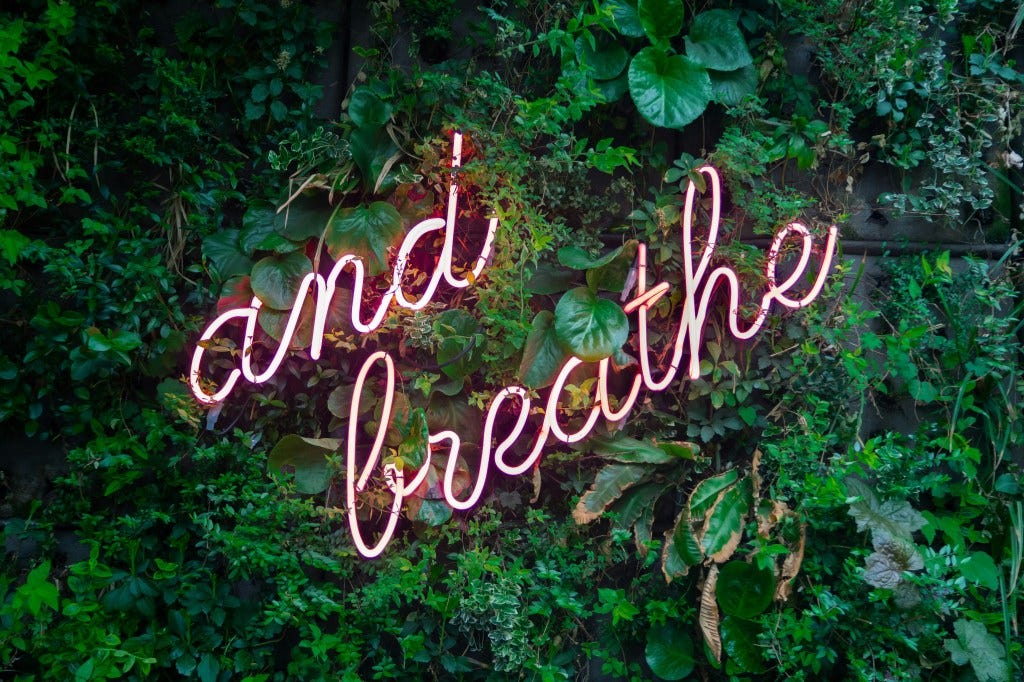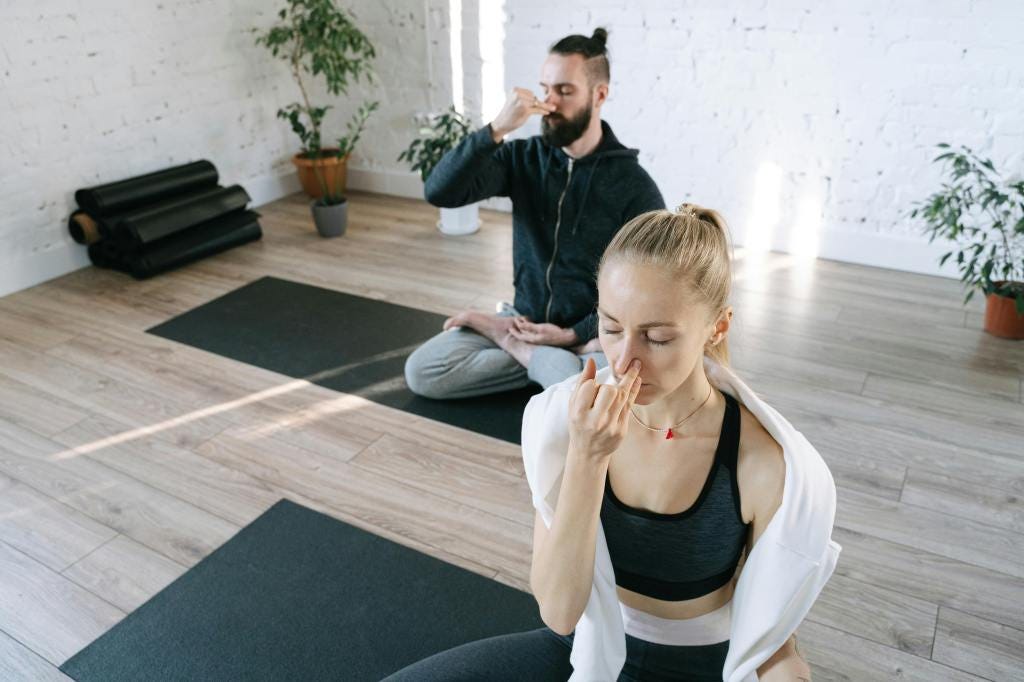Breathwork 101
Discover the power of breathwork—a potent tool to conquer stress. Uncover what it entails, what to expect, and more.
Welcome to Breathwork 101! Imagine having the power to control your mind, body, and emotions with something as simple as your breath. Breathing isn't just an automatic function—it's a gateway to improved health, reduced stress, and a deeper connection to yourself. In this post, we'll explore how mastering your breath can transform your life. Get ready to breathe your way to a better you!
Breathing is a fascinating and vital part of our physiology, one of the few things that can be controlled both involuntarily and voluntarily. Usually, it doesn’t require any thought because it’s regulated by the autonomic nervous system, which is part of the peripheral nervous system and manages involuntary processes like heart rate, blood pressure, respiration, digestion, and sexual arousal.

Why do we breathe?
Breathing helps us absorb oxygen and expel carbon dioxide through the movement of the lungs. The diaphragm, a muscle beneath the lungs, and the intercostal muscles between the ribs control this process. Everyday functions such as digestion, muscle movement, and even thinking require oxygen. Essentially, breathing is the foundation of our vitality!
Stress and Breathing
When a person is under stress, either physically or emotionally, this affects how they breathe. Typically, a person experiencing anxiety will take small, shallow breaths, using their chest and shoulders, called thoracic breathing. Basically this means they are using their shoulders rather than their diaphragm to move air in and out of their lungs. This style of breathing disrupts the balance of gasses in the body.
Shallow over-breathing can prolong feelings of anxiety by making the physical symptoms of stress worse. Using breathwork techniques to control your breathing can help to improve some of those symptoms, and help you to feel better, faster!
When we breathe in a shallow way, the body remains in a cyclical state of stress. Our stress causes shallow breathing and our shallow breathing causes stress. This can prolong the feelings of anxiety by making the physical symptoms of stress worse. This sets off the sympathetic, or fight or flight branch of our autonomic nervous system, which is priming us for activity and response.
How should we be breathing?
Look at any baby, and you’ll see what a pro breather looks like! They are naturals at deep, slow diaphragmatic breathing. Their bellies expand and their chest rises as they inhale through the nose and into the lungs. When they exhale, their bellies contract.
Generally, as adults, this type of breathing is no longer instinctive to us. Most of us have become shallow chest, or thoracic, breathers. We inhale through the mouth, hold our breath, and take in less air. There are many reasons we might have shifted to this kind of breathing, from environmental stressors such as temperature, pollution, noise and other causes of anxiety.
Some speculate that our cultural expectations, which can often include having a flat stomach, encourage us to hold our breath and suck in our stomachs, which can further tighten our muscles. Shallow breathing doesn’t just make stress a response, it makes stress a habit in our bodies, and therefore our minds, get locked into.
Dangers of shallow breathing
Long-term shallow breathing can also seriously affect our health. The chronic stress that is associated with shallow breathing results in lower amounts of lymphocyte, which is a type of white blood cell that helps to defend the body from invading organisms, and lowers the amount of proteins that signal other immune cells. This means the body is susceptible to contracting acute illness, aggravating pre-existing medical conditions, and prolonging healing times.
Shallow breathing can also turn into panic attacks, cause dry mouth and fatigue, aggravate respiratory problems, and is a precursor for cardiovascular issues. It can also create tension in other parts of our bodies and lead to everyday problems.
Benefits of deep breathing
Deep breathing grounds us. It can help intense sensations, experiences, and emotions feel less threatening. Deep breathing brings awareness which can help us to breathe mindfully, and feel calmer. A recent study showed a direct link between nasal breathing and cognitive function. People were proven more likely to remember an object and more quickly able to identify a fearful face when inhaling and exhaling through the nose. The enhanced memory recall and emotional judgement disappeared when breathing was done through the mouth.
On the flip side, when a person is relaxed, they breathe through their nose in slow, even and gentle breaths. Purposely copying this style of breathing seems to calm the nervous system that controls so many of the body’s involuntary functions. Sort of a fake it, till you make it kind of deal. Using breathwork techniques to control your breathing can help to improve some of those symptoms, and help you to feel better, faster!
You might be wondering now, what are the physiological changes that happen when I control my breathing? Well we’ve got a list, and they are all good things Some of the changes include:
Lowered blood pressure and heart rate
Reduced stress hormones
Enhanced immune function
Increased energy and calm
Breathwork Techniques
Breathwork includes a variety of breathing techniques, programs, and exercises that emphasize mindful awareness of inhalation and exhalation. These exercises often involve deep, focused breathing for a specific amount of time and are aimed at improving health. People use breathwork for:
Boosting immunity and self-awareness
Healing emotional pain
Enhancing creativity
Reducing stress and anxiety

Breathing Practices
Let’s explore some common breathwork techniques that you can try at home. Remember to consult with a doctor before beginning any breathwork therapy, especially if you have a medical condition, take medications, or are pregnant or breastfeeding.
Diaphragmatic breathing
Diaphragmatic breathing, or belly breathing, involves moving the stomach, not the chest, with each breath—expanding while inhaling and contracting while exhaling. This type of breathing can distract and quiet the mind, offering benefits like reduced blood pressure and heart rate and improved relaxation. To practice:
Lie on your back on a flat surface with knees bent and head supported.
Place one hand on your upper chest and the other just below your rib cage to feel your diaphragm move.
Breathe in slowly through your nose, causing your stomach to move out and your hand to rise (the hand on your chest should remain still).
Tighten your stomach muscles to move your stomach in, causing your hand to lower as you exhale through your nose or pursed lips (the hand on your chest should remain still).
Start with 5-10 minutes of practice 3-4 times a day, gradually increasing time as you become more comfortable. You can also try this technique while sitting in a chair, keeping your knees bent and your shoulders, head, and neck relaxed.
Pursed lip breathing
Pursed lip breathing is a simple technique to control shortness of breath, slowing your breathing pace to make each breath more effective. This technique can improve ventilation, release trapped air in your lungs, relieve shortness of breath, and promote general relaxation. To practice:
Relax your neck and shoulders.
Breathe in slowly through your nose for two seconds with your mouth closed.
Purse your lips as if you’re going to whistle or blow on something hot.
Breathe out slowly and gently through your pursed lips for four or more seconds.
Practice 4-5 times a day for at least 5-10 minutes. Once it feels natural, use it whenever necessary.
Box breathing
Box breathing, or square breathing, is a simple yet powerful tool for managing stress and anxiety. Used even by US Navy SEALs in high-stress situations, it’s based on pranayama, an ancient Ayurvedic breathwork practice. Box breathing can reduce stress and anxiety, improve focus and concentration, lower heart rate and blood pressure, enhance relaxation and sleep quality, and promote emotional balance. To practice:
Find a quiet space to sit or lie comfortably.
Close your eyes if possible.
Inhale through your nose for four seconds, filling your lungs and drawing in energy.
Hold the breath for four seconds.
Exhale slowly through the nose for four seconds, releasing stress and worries.
Hold your breath for another four seconds.
Start with a few minutes daily, gradually increasing as you become more comfortable. Adjust the timing to three or five seconds if needed, ensuring equal segments.
4-7-8 Breathing
Developed by Dr. Andrew Weil, the 4-7-8 breath is a "natural tranquilizer for the nervous system," based on the ancient yogic practice of pranayama. It helps regulate the nervous system, manage anxiety and stress, and improve sleep. To practice:
Place the tip of your tongue behind your upper front teeth.
Empty your lungs of air.
Breathe in quietly through your nose for four seconds.
Hold your breath for seven seconds.
Exhale forcefully through your mouth for eight seconds, making a “whoosh” sound.
Repeat up to four times in one sitting. Consistent practice can help regulate cortisol levels, reduce anxiety, and improve overall well-being.

Alternate nostril breathing
Alternate nostril breathing, or nadi shodhana pranayama, is a yogic breath control practice that can help you relax and lower stress. It’s been shown to reduce blood pressure, improve lung function, and enhance memory and motor skills. To practice:
Sit comfortably with your spine straight and shoulders relaxed.
Close your eyes.
Place your right thumb on your right nostril.
Inhale through your left nostril.
Close your left nostril with your right ring finger and little finger.
Open your right nostril and exhale.
Inhale through your right nostril.
Close your right nostril and exhale through your left nostril.
Repeat for up to five minutes, always finishing with an exhale on the left side.
Physiological Sigh Breathing
The physiological sigh is a natural response when oxygen levels are low, even during sleep. This breathing technique, studied by Andrew Huberman’s lab, is effective for reducing stress in real-time. To practice:
Take two short inhales through your nose.
Follow with one long exhale through your mouth.
Repeat one to three times. This technique activates the parasympathetic nervous system, lowering heart rate and reducing stress.
Five Finger Breathing
Recommended by Dr. Judson Brewer, this technique can help slow down a racing mind. It shifts focus from worried thoughts to multi-sensory awareness, calming both mind and body. To practice:
Place the index finger of one hand on the outside of the pinky finger of your other hand.
Inhale as you trace up to the tip of your pinky, and exhale as you trace down the inside.
Continue this pattern for each finger.
Reverse the process, tracing from your thumb back to your pinky. This multi-sensory approach can help reduce anxiety and improve focus.
Breathwork is a versatile and powerful tool for improving mental, physical, and spiritual well-being. By exploring different techniques and finding what works best for you, you can harness the power of breath to reduce stress, enhance focus, and promote overall health.
Whether you’re practicing diaphragmatic breathing, pursed lip breathing, box breathing, 4-7-8 breathing, or any of the others we’ve covered here, consistent practice can lead to significant benefits! You gotta put in those reps to reap the rewards. Having a time of day to do your breathing exercise can really help, like in the morning before things get busy, or in the evening to help you unwind before bed.
Remember to start slowly, listen to your body, and consult a healthcare provider if you have any concerns. Happy breathing!
Enjoyed this? Here’s what we recommend next: Mindfulness 101




Another banger! Great and well-explained breathing strategies!
I truly believe intentional breathing offers the bridge between our rational and emotional minds. When emotions take over and we are aware we are in a less than ideal state, consciously taking over the autonomic function of breathing is the most efficient path to rationality. So much opportunity when we make this process one we consciously control.
Thanks Gen!